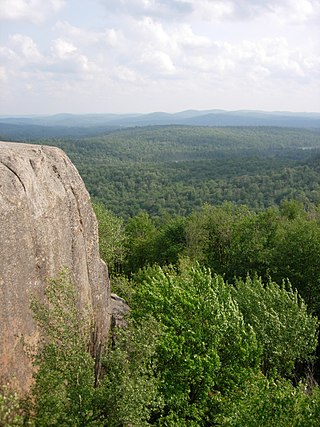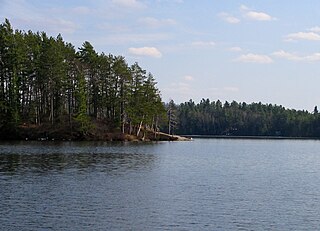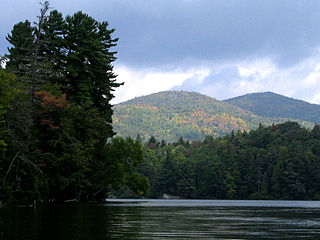
The Adirondack Mountains are a massif of mountains in Northeastern New York which form a circular dome approximately 160 miles (260 km) wide and covering about 5,000 square miles (13,000 km2). The region contains more than 100 peaks, including Mount Marcy, which is the highest point in New York at 5,344 feet (1,629 m). The Adirondack High Peaks, a traditional list of 46 peaks over 4,000 feet (1,200 m), are popular hiking destinations. There are over 200 named lakes with the number of smaller lakes, ponds, and other bodies of water reaching over 3,000. Among the named lakes around the mountains are Lake George, Lake Placid, and Lake Tear of the Clouds. The region has over 1,200 miles (1,900 km) of river.

Santa Clara is a town in Franklin County, New York, United States. The population was 332 at the 2020 census, down from 345 at the 2010 census. The name was derived from the wife of an early town businessman, John Hurd.

The Adirondack Park is a park in northeastern New York protecting the Adirondack Mountains. The park was established in 1892 for "the free use of all the people for their health and pleasure", and for watershed protection. At 6.1 million acres, it is the largest park in the contiguous United States.

The Raquette River, sometimes spelled Racquette, originates at Raquette Lake in the Adirondack Mountains in the U.S. state of New York. 146 miles (235 km) long, it is the third longest river entirely in the state of New York.

The St. Regis River is an 86-mile-long (138 km) river in northern New York in the United States. It flows into the Saint Lawrence River at the hamlet of Saint Regis in the St. Regis Mohawk Reservation. The Saint Regis River basin includes Upper and Lower St. Regis Lakes, and Saint Regis Pond in the Saint Regis Canoe Area. It's a great fishery for trout.

The Saranac River is an 81-mile-long (130 km) river in the U.S. state of New York.

Paul Smiths is a hamlet and census-designated place (CDP) in the town of Brighton in Franklin County, New York, United States. It is located on Lower Saint Regis Lake in the Adirondacks, 12 miles (19 km) northwest of Saranac Lake, located at 44°26' North 74°15' West. The population of the CDP was 671 at the 2010 census.
Lake Clear is a hamlet and a lake in Franklin County, New York, United States. The area is named for 940-acre (3.8 km2) Lake Clear, part of the original Seven Carries canoe route. It is located in the town of Harrietstown.

The Five Ponds Wilderness Area, an Adirondack Park unit of New York's Forest Preserve, is located in the towns of Fine and Clifton in St. Lawrence County, the town of Webb in Herkimer County and the town of Long Lake in Hamilton County. It includes 1,064 acres (4.3 km2) of private inholdings, 99 bodies of water covering 1,964 acres (7.9 km2), 57.9 miles (93.2 km) of trails, and 14 lean-tos.
Saint Regis may refer to:

Upper St. Regis Lake is a 742-acre (3.00 km2) lake, part of the St. Regis River in the Adirondacks in northern New York State. Along with Lower St. Regis Lake and Spitfire Lake, it became famous in the late 19th century as a summer playground of America's power elite, drawn to the area by its scenery and Paul Smith's Hotel. It is the site of many old summer "cottages" and Great Camps, including Marjorie Merriweather Post's Topridge. Frederick W. Vanderbilt, Anson Phelps Stokes and Whitelaw Reid were among the summer residents. "The camps of many of these families began as tent colonies, with separate units for sleeping, dining, games, and so on, and evolved into permanent structures built with understated taste."

Lower St. Regis Lake is a part of the St. Regis River in the Adirondacks in northern New York State. At its northern edge is Paul Smith's College, former site of Paul Smith's Hotel. Along with Upper St. Regis Lake and Spitfire Lake, it became famous in the late 19th century as a summer playground of America's power elite, drawn to the area by its scenic beauty and by the rustic charms of Paul Smith's Hotel. It is the site of St. John's in the Wilderness, a small chapel originally built of logs, that was formerly attended by the families of shoreline property owners that arrived in canoes, rowboats and sailboats.

Saint Regis Pond is a 388-acre (1.57 km2) pond, the largest in the Saint Regis Canoe Area in the Adirondacks in northern New York state. It drains into the west branch of the St. Regis River. It is part of the "Seven Carries" canoe route.

The Seven Carries is an historic canoe route from Paul Smith's Hotel to the Saranac Inn through what is now known as the Saint Regis Canoe Area in southern Franklin County, New York in the Adirondack Park. The route was famous with sportsmen and tourists from major east-coast cities from the late 19th century through the 1930s; interest has revived in recent years. Despite the name, the route consists of only six carries, or portages.

Keese Mill—better known locally as Keese's Mills, but also spelled as Keeses Mill and Keeses Mills—is a hamlet west of Paul Smiths in the Town of Brighton, Franklin County, New York, United States, in the Adirondacks. It is named for a settlement established by employees of the two sawmills established by Keese and Tomlinson near their dam on the outlet of Lower St. Regis Lake Saint Regis River in mid-nineteenth century.

The Saranac Lakes Wild Forest is a discontinuous 79,000-acre (320 km2) tract designated as Wild Forest by the New York State Department of Environmental Conservation in Franklin and Essex Counties near Saranac Lake, Tupper Lake, and Lake Placid. The area covers large portions of Harrietstown, Santa Clara, and North Elba; smaller portions are in Altamont, St. Armand, Brighton, and Franklin. The area is served by State Routes NY-3, NY-30, NY-86, and NY-73.
The Debar Mountain Wild Forest is a 83,405-acre (337.53 km2) tract designated as Wild Forest by the New York State Department of Environmental Conservation in the northeastern Adirondack Park, just north of Paul Smiths, in Franklin County. The area includes 61,500 acres (249 km2) of state land and 60,600 acres (245 km2) of conservation easement land. The area is served by state routes NY-3, NY-30 and NY-458.

The Adirondack Canoe Classic, also known as the 90-miler, is a three-day, 90-mile (140 km) canoe race from Old Forge to Saranac Lake in the Adirondacks of New York, United States. The race has drawn as many as 500 competitors from California to Florida, New Zealand and Canada paddling 250 canoes, kayaks and guideboats. Included in the ninety mile length is 5.25 miles (8.45 km) of carries.

Saint Regis Mountain is a 2,838-foot-tall (865 m) mountain in the town of Santa Clara, New York, in Franklin County at the center of the Saint Regis Canoe Area in the Adirondack Park.














